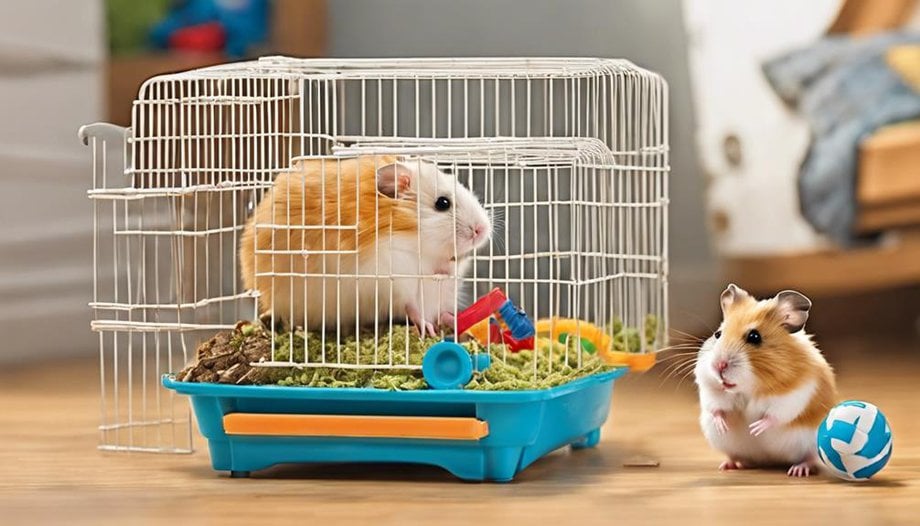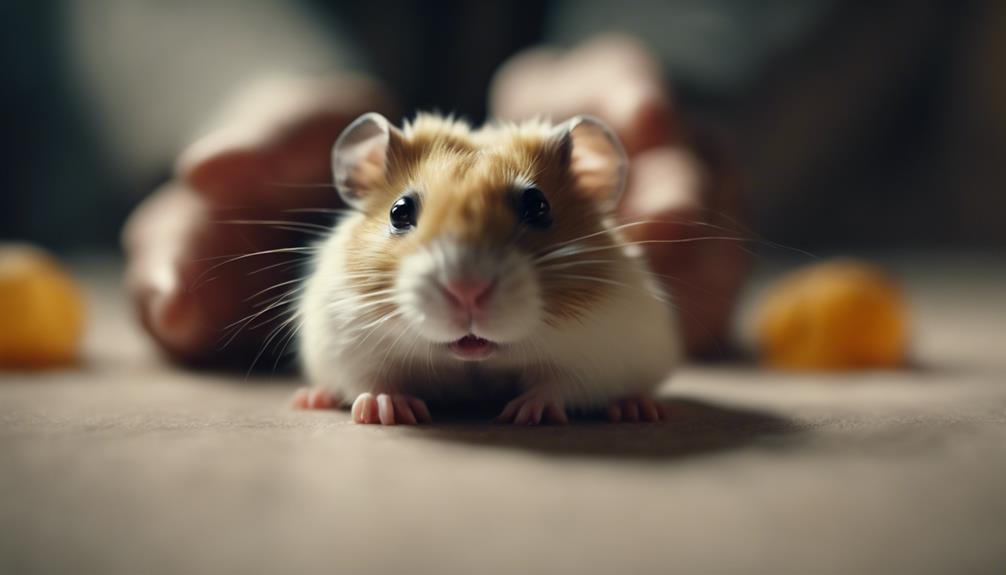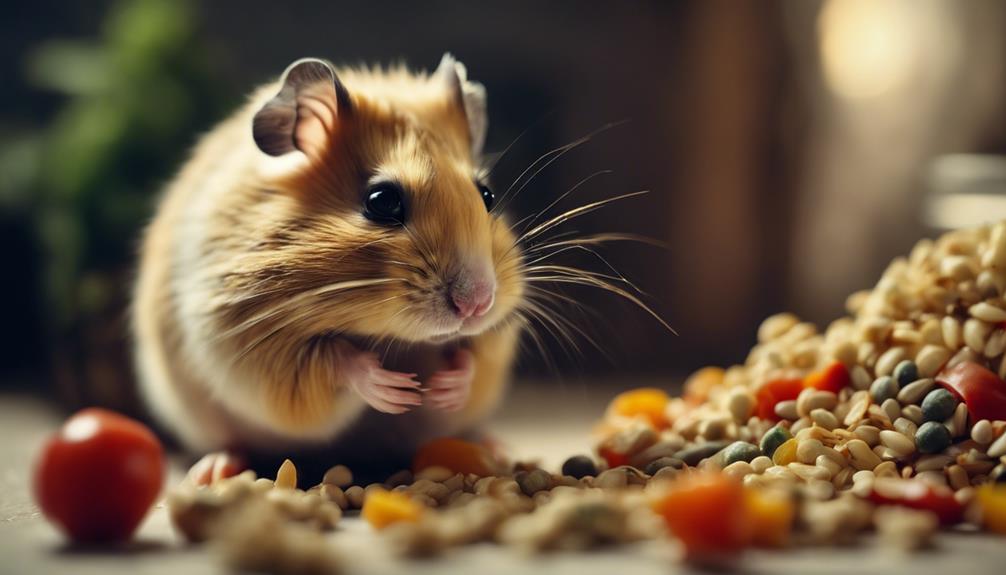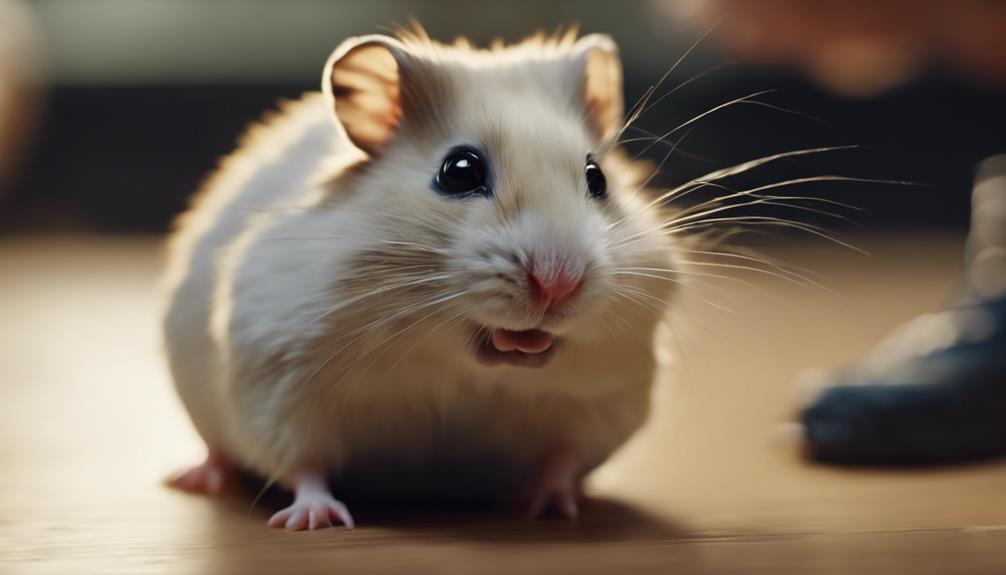How to Manage Aggression in Hamsters: Species-Specific Tips

Hamsters can sometimes exhibit aggressive behavior due to various reasons, such as feeling threatened or territorial. It is important for pet owners to understand these triggers and implement strategies to manage aggression in their hamsters.
Here are some key tips to help pet owners deal with aggression in their hamsters:
- Provide a suitable living environment that meets the hamster's needs, including enough space, hiding spots, and enrichment activities to prevent boredom and frustration.
- Handle your hamster gently and with care to build trust and minimize stress. Avoid sudden movements or loud noises that can startle the hamster.
- Monitor your hamster's body language for signs of aggression, such as hissing, biting, or raised fur. If you notice these behaviors, give your hamster space and time to calm down.
- Avoid reaching into your hamster's cage when it is sleeping or eating, as this can trigger defensive behavior. Instead, let the hamster come to you on its terms.
- If your hamster continues to display aggressive behavior, consult with a veterinarian or an animal behaviorist for further guidance and support in managing aggression.
By understanding your hamster's needs and behavior, you can create a safe and comfortable environment that minimizes aggression and promotes a positive relationship between you and your pet.
Understanding Hamster Aggression
To comprehend hamster aggression, one must delve into the intricacies of their behavior and triggers. Aggression prevention in hamsters involves implementing behavior modification techniques and training strategies. By understanding the underlying causes of aggression in these small creatures, one can effectively address and manage their behavior.
Training techniques play a crucial role in shaping a hamster's behavior towards a more socialized and less aggressive state. Socialization strategies, such as positive reinforcement and interactive play, can help in reducing instances of aggression. It's essential to provide a stimulating environment for hamsters, allowing them to engage in natural behaviors and activities that promote mental and physical well-being.
Recognizing Triggers and Cues
To effectively manage aggression in hamsters, it's crucial to recognize the triggers and cues that can lead to confrontational behavior. By identifying common triggers and understanding their body language, owners can proactively prevent potential outbursts.
Responding calmly and assertively to these cues is key in de-escalating tense situations and fostering a safe environment for both the hamster and its human companions.
Identify Common Triggers
Amidst the complexities of hamster behavior, recognizing common triggers plays a pivotal role in managing aggression effectively. By understanding what factors may provoke aggressive responses in hamsters, owners can employ aggression prevention strategies, training techniques, behavior modification, and stress reduction methods to create a harmonious environment for their pets.
Common triggers for aggression in hamsters often include feeling threatened, being startled, encountering unfamiliar scents or noises, experiencing overcrowding, or facing territorial disputes. By identifying these triggers early on and addressing them proactively, owners can help prevent potential conflicts and create a calmer and safer space for their furry companions.
Recognizing these common triggers is the first step towards fostering a happy and peaceful bond with pet hamsters.
Understand Body Language
Understanding body language in hamsters is crucial for recognizing triggers and cues that may lead to aggression. By being attuned to their communication cues, hamster owners can preemptively address potential conflicts and create a harmonious environment. Behavior modification techniques can then be utilized to positively influence aggressive tendencies. Below is a table to help interpret common hamster body language:
| Body Language | Meaning |
|---|---|
| Flattened ears | Agitation or fear |
| Bared teeth | Aggression |
| Rapid grooming | Stress or discomfort |
| Stiff posture | Readiness to attack |
Respond Calmly and Assertively
How can hamster owners effectively respond to aggression triggers and cues while maintaining a calm and assertive demeanor?
Dealing with defiance in hamsters requires a delicate balance of understanding and firmness. When a hamster displays signs of aggression, such as biting or hissing, it's crucial to establish boundaries promptly. Owners shouldn't tolerate aggressive behavior but should respond calmly and assertively.
By recognizing triggers and cues, such as sudden movements or invading their personal space, owners can proactively prevent escalation. It's essential to communicate authority without resorting to aggression oneself. Remember, hamsters respond well to consistent and confident leadership.
Through a combination of patience, observation, and clear communication, owners can effectively manage aggression in their hamsters while maintaining a harmonious relationship.
Providing Adequate Enrichment
To ensure hamsters' well-being and mental stimulation, it's imperative to provide them with a variety of enriching activities and toys in their habitat. Enrichment activities such as providing different textures for them to explore, tunnels to run through, and chew toys can keep hamsters engaged and prevent boredom-induced aggression.
Bonding exercises like gentle handling and spending time near their cage can help build trust and reduce stress. Playtime ideas such as creating a safe playpen outside their cage and offering interactive toys like running wheels can offer physical exercise and mental stimulation.
Additionally, cage upgrades such as adding platforms, hiding spots, and materials for burrowing can enhance their environment and provide opportunities for natural behaviors. By incorporating these enrichment strategies into a hamster's daily routine, owners can create a stimulating and fulfilling environment that promotes positive behaviors and minimizes aggression.
Handling and Socializing Techniques

When it comes to handling and socializing techniques for hamsters, gentle methods and positive interactions play a crucial role in building trust and reducing aggression.
By approaching these small creatures with patience and kindness, individuals can foster a sense of security and comfort in their hamsters, promoting a harmonious relationship.
Implementing these practices consistently can lead to a happier and more sociable pet that thrives in its environment.
Gentle Handling Methods
Implementing gentle handling methods is crucial for fostering trust and reducing aggression in hamsters. When it comes to bonding techniques and the taming process, the following strategies can help cultivate a positive relationship with these small creatures:
- Quiet Environment: Ensure the handling area is calm and free from loud noises to reduce stress.
- Hand-Fed Treats: Offer treats from your hand to associate your presence with positive experiences.
- Slow Approach: Approach your hamster calmly and gently, allowing them to sniff and investigate you at their own pace.
Encouraging Positive Interactions
Encouraging positive interactions with hamsters involves fostering a sense of trust and companionship through gentle handling and socializing techniques. Positive reinforcement is key in building a strong bond with your furry friend.
When handling your hamster, approach them calmly and speak softly to reassure them. Allow your hamster to sniff your hand before gently scooping them up, supporting their body securely. Socialization techniques such as providing interactive toys and safe play areas can also promote positive interactions.
Spend time near your hamster's cage, talking to them and offering treats to associate your presence with positive experiences. By consistently using gentle handling and positive reinforcement, you can create a harmonious relationship with your hamster based on trust and mutual respect.
Creating a Safe Environment
To ensure the well-being of your hamster and minimize aggressive behavior, creating a safe environment is paramount. Hamsters, like all creatures, thrive in environments that cater to their natural instincts and provide security. Here are some essential tips to consider:
- Provide Enrichment Activities: Incorporating toys, tunnels, and wheels in your hamster's habitat not only keeps them mentally stimulated but also helps burn off excess energy, reducing the likelihood of aggressive behavior.
- Ensure Safe Handling: When interacting with your hamster, it's crucial to handle them gently and with care. Sudden movements or mishandling can cause stress and lead to defensive behaviors.
- Maintain a Quiet Environment: Hamsters are sensitive to loud noises and sudden disturbances. Creating a peaceful and calm living space for your pet can help keep them relaxed and less prone to aggression.
Implementing Diet and Nutrition Changes

Creating a well-balanced diet tailored to your hamster's specific nutritional needs is essential for promoting overall health and curbing aggressive tendencies. Dietary adjustments play a crucial role in managing aggression in hamsters. Nutritional changes can have a significant impact on your pet's behavior, as certain deficiencies or imbalances may lead to increased stress levels and irritability.
To implement diet and nutrition changes effectively, start by providing a high-quality hamster food that meets their dietary requirements. Supplement this with fresh fruits, vegetables, and occasional treats to ensure a varied diet. Monitor your hamster's food intake to prevent overeating, which can also contribute to aggressive behavior.
Incorporating behavior modification techniques alongside nutritional adjustments can yield positive results in aggression management. Encourage mental stimulation through interactive toys and activities to keep your hamster engaged and content. Remember, a healthy diet and a stimulating environment are key components in fostering a peaceful and harmonious relationship with your furry friend.
Seeking Veterinary Support
How can veterinary support benefit in addressing your hamster's aggression issues?
Veterinary intervention plays a crucial role in understanding and managing your hamster's aggressive behavior. Seeking professional guidance can provide valuable insights into the underlying causes of aggression, leading to effective behavior modification strategies tailored to your hamster's specific needs.
When considering veterinary support for your aggressive hamster, keep in mind the following:
- Behavior Evaluation: Veterinarians specializing in exotic pets can conduct thorough assessments to pinpoint triggers of aggression and recommend appropriate interventions.
- Training Techniques: Veterinary professionals can offer guidance on positive reinforcement training methods to encourage desirable behaviors and discourage aggression in hamsters.
- Medication: In severe cases where aggression is rooted in health issues, veterinarians may prescribe medication to alleviate pain or discomfort, which could be contributing to aggressive tendencies.
Monitoring Progress and Adjusting Strategy

Monitoring the progress of behavior modification strategies and adjusting them accordingly is paramount in effectively managing aggression in hamsters. Behavior tracking allows owners to observe patterns and identify triggers that may lead to aggressive behavior. By consistently monitoring their hamster's actions, individuals can gain valuable insights into what works and what doesn't in terms of behavior modification.
Progress evaluation is essential to gauge the effectiveness of the implemented strategies. Through regular assessments, owners can determine if the aggression is decreasing, increasing, or remaining constant. If the current approach isn't yielding the desired results, it's crucial to adjust the strategy promptly.
Strategy adjustment involves making necessary changes based on the evaluation of progress. This could involve tweaking the environment, altering interaction techniques, or seeking additional support from a veterinarian or animal behavior specialist. Flexibility and adaptability are key when managing aggression in hamsters, as each furry companion is unique and may respond differently to various interventions. Remember, patience and consistency are fundamental virtues when embarking on this journey of behavior modification.
Frequently Asked Questions
Can Aggression in Hamsters Be Influenced by the Breed or Species of Hamster?
Genetic influences play a role in hamster aggression, with breed characteristics affecting behavior. Behavioral differences can be influenced by species-specific traits, impacting how aggression triggers manifest in different types of hamsters.
Are There Any Specific Signs or Behaviors That Indicate a Hamster Is Becoming Aggressive?
When a hamster is becoming aggressive, behavioral cues like biting, hissing, or raised fur may indicate discomfort. Proper handling techniques, gentle training methods, and adjusting environmental factors can help manage aggression and create a harmonious relationship with the pet.
How Can I Prevent Aggression Between Multiple Hamsters in the Same Enclosure?
To prevent aggression between multiple hamsters in the same enclosure, focus on understanding group dynamics and managing the environment effectively. Encourage positive socialization techniques and provide ample space, resources, and opportunities for each hamster to establish their territory and feel secure.
Are There Any Natural Remedies or Supplements That Can Help Reduce Aggression in Hamsters?
Herbal remedies and dietary supplements can complement behavioral therapy in managing hamster aggression. Encouraging an exercise routine can also help reduce stress levels. Combining these elements can create a holistic approach to promoting a harmonious hamster environment.
What Role Does Gender Play in Hamster Aggression, and How Can I Manage Aggression Between Male and Female Hamsters?
When dealing with hamster aggression, understanding gender dynamics is crucial. Behavioral management plays a key role in maintaining harmony between male and female hamsters. Consistent observation and proactive intervention can help mitigate conflicts and foster a peaceful coexistence.









